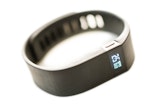Chapter.01/06
What is the Internet of Things?
What is the Internet of Things?
Chapter 01/06
What is the Internet of Things?
Most of us have gotten used to hopping on the internet whenever we want to post on social media, read the news or stream a TV show on a phone, tablet or computer.
But internet connectivity has spread from these familiar uses to permeate many other parts of our daily lives. Whether through smart-home devices, such as smartphone-controlled thermostats and Wi-Fi-connected lightbulbs, or smart-city innovations, like traffic-sensing streetlights and self-driving cars, we’re interacting with a large and rapidly growing array of technologies that are wirelessly connected to the internet.
IoT Defined

You may not have a personal computerized butler system à la J.A.R.V.I.S. from the Avengers movies (although Alexa comes pretty close), but internet-connected devices like these talk to each other to make up what’s now known as the internet of things (IoT).
The IoT is the worldwide network of internet-connected automated devices that sense and collect environmental data in order to allow users to monitor and control that environment.
These environmental sensors, sometimes called embedded devices, have been around since the 1960s view citation[1] ; but it’s only with the development of internet connectivity and cloud storage that the IoT has become the phenomenon we know today.
IoT devices have three key properties view citation[2] :
- They’re physical objects, like a FitBit wrist-worn fitness tracker or an Amazon Echo Dot smart speaker.
- They collect data from the environment around them, such as temperature, heart rate or voice commands.
- They’re connected to the internet (and often to apps on your smartphone) so they can perform their intended functions.

A Brief History
Kevin Ashton of Procter & Gamble coined the term “internet of things” in 1999 in reference to radio-frequency identification (RFID) technology, view citation[3] or electromagnetic tags that can be read to identify objects. These are the square, shiny, circuit-like tags you find inside video game or DVD boxes, or embedded in clothing tags to prevent shoplifting. RFID is also the basis for the location-tracking microchips implanted in pets and even people.
Since then the practice of embedding RFID tags in a wide variety of objects has emerged as a significant element of the IoT, from replica jerseys that let fans access to exclusive content at sports games, view citation[4] to tags that keep track of every single nut, bolt and piece of equipment in the International Space Station. view citation[5]
IoT All Around
Explore how firefighters can use IoT in a rescue.
Nice job! Keep reading or start over to try again.
You are a firefighter responding to an emergency call with your brigade. What IoT tool could you use to identify how many people are still trapped inside the burning building?
Correct!
With footage from the building’s security cameras, you can see the real-time location of anyone still inside.
Incorrect
Incorrect. Medics may use a health monitor at the scene later, but it won’t be much help now.
Incorrect
Smart concrete can detect structural damage which can prevent buildings from collapsing.
Incorrect
That will come in handy later, but you can see the real-time location of anyone still inside with footage from the building’s security cameras.
At the scene, your team is assessing what areas of the fire are most likely to spread and cause additional damage. What smart device would you use?
Correct!
Drones equipped with thermal imaging technology can send video to the team on the ground to help them understand where the fire is.
Incorrect
While it would be helpful to clear a direct route on the way to the fire, this wouldn’t help you find a new way to enter the building.
Incorrect
Some smart sprinklers do have built-in cameras, but you would most likely be unable to locate an additional entrance using their data.
Incorrect
These devices can provide important situation updates, but are unable to provide floorplan data.
Once inside the building, you notice that the structure has sustained a lot of damage. What device or tool could you use to find out how long you can safely remain inside the structure before collapse?
Incorrect
A drone would be helpful to survey the exterior of the building, but wouldn’t be very useful inside.
Correct!
Smart concrete can detect structural damage which can notify responders if a building is close to collapsing.
Incorrect
Some smart sprinklers do have built-in cameras, but you would most likely be unable to gather any data about the building’s integrity.
Incorrect
These devices can help the team keep track of a firefighter’s location once inside, but are unable to provide real-time structural data.
Now that Wi-Fi and cellular data connections are becoming more prevalent in our perpetually internet-connected world, view citation[7] more and more everyday devices are being equipped with the ability to connect to the internet. And when these devices include sensors, the possibilities for gathering a wide variety of information—monitoring or recording video, taking temperature readings, counting particulate matter in the air—are nearly endless. Internet connectivity allows individual sensors to form a collective—the IoT—that’s greater than the sum of its parts.
This network of devices can be incredibly convenient and efficient. A smart thermostat, for example, can use its embedded motion and temperature sensors to save energy by lowering the temperature when no one’s home. view citation[7] When a smart refrigerator senses that you’ve run out of butter, it can send you a message reminding you to pick some up at the store. view citation[8]

The IoT also holds great potential benefits for health and wellness.
Imagine being able to monitor your sleeping habits with a smart mattress that tracks your heart rate, number of hours slept, hours of restless sleep and percentage of the time you spent in deep sleep. Knowing this information could help you better manage your health. In addition, if you connected your smart mattress to your other smart devices, like your smart alarm, the networked devices can pool their information to determine when you are physiologically most ready to wake up and then set off a soothing alarm to ease you awake.
In elder care and assisted-living facilities, IoT devices can be embedded in clothing, lighting and even the floors to predict and prevent falls by monitoring and analyzing residents’ locations and gaits in real time. Wireless temperature sensors can keep track of refrigerator and room temperatures, which can help reduce instances of food poisoning and keep residents at safe body temperatures.

In construction, smart helmets can monitor construction workers’ biometric data such as body temperature, preventing overexertion and overheating on the job site. Structures and building materials embedded with sensors can monitor and predict defects and structural instabilities, warning users of a structural failure before it occurs. Technology like this could save millions of dollars—not to mention lives.
The IoT also has exciting implications for criminal investigations. For instance, police and attorneys have used data from FitBits, smart doorbells, a smart water meter and an Amazon Echo speaker in a variety of criminal cases. view citation[9]
It may be strange to imagine every aspect of your life pervaded by the kind of gadgetry you’d see in a science fiction movie, but that future is right around the corner. The internet of things is here.
References
-
“Introduction to Embedded Systems.” Miguel Jimenez. 2014. View Source
-
“Cybersecurity in the age of always-connected sensors.” World Economic Forum, via YouTube. View Source
-
“Kevin Ashton Describes the Internet of Things.” Smithsonian.com. January 2015. View Source
-
“Nike’s 'NBA Connected' jerseys tap into the game with NFC tags.” Engadget. September 2017. View Source
-
“RFID-Enabled Autonomous Logistics Management (REALM).” NASA. View Source
-
“Gartner Says 8.4 Billion Connected “Things” Will Be in Use in 2017, Up 31 Percent From 2016.” Gartner. February 2017. View Source
-
“Learn how Home/Away Assist works.” Google Nest Help. View Source
-
“Behold Samsung’s New $5,800 Smart Refrigerator.” Time. May 2016. View Source
-
“From fraud to murder, why forensics firms are selling software to smart home sleuths.” CBC. August 2017. View Source
Next Section
The Technologies Behind the Internet of Things
Chapter 02 of 06
Discover how IoT devices mimic human senses to observe, record, and make sense of the world around them. Learn how the internet allows these devices to become more than the sum of their parts.

